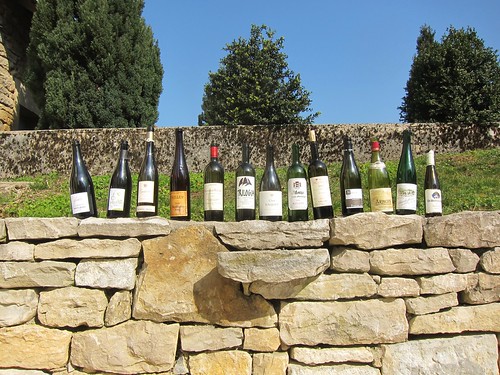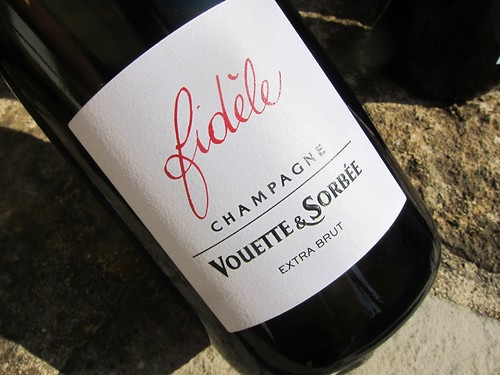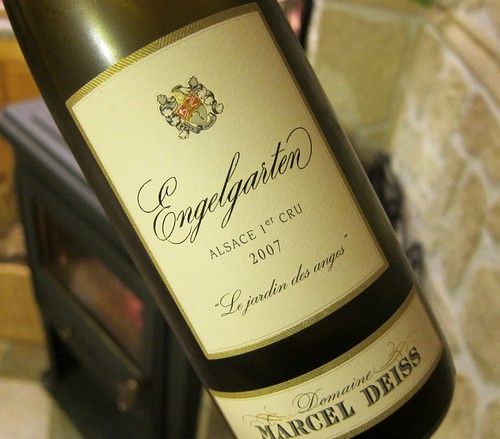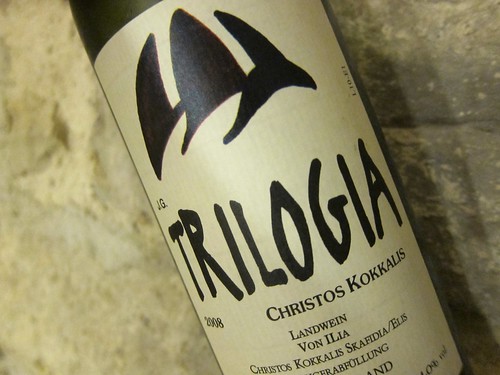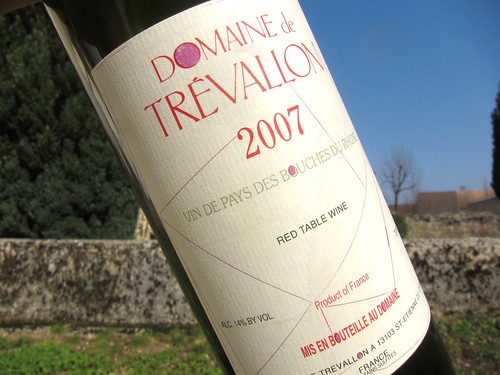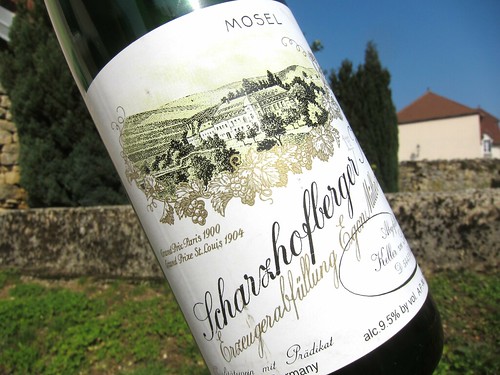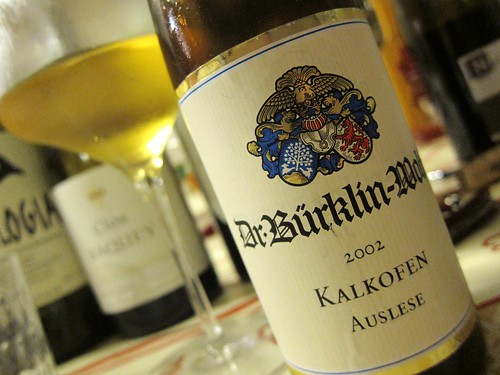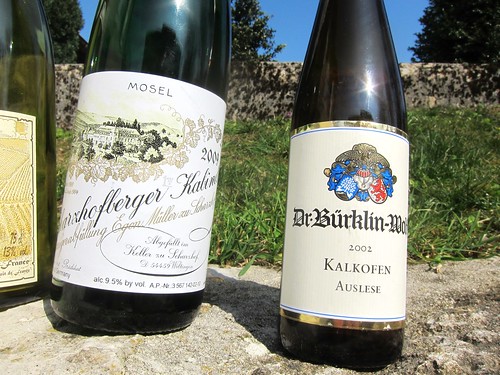Last weekend was awesome! Together with some friends I was lucky to be welcomed by Didier from Vimpressionistes in a cosy holiday appartment in the beautiful village of Château Chalon in the Jura region of Eastern France. First of all, to finally meet his beautiful baby-daughter but of course also to indulge a memorable blindtasting.
But don’t expect a Vin Jaune or Savagnin tasting here. That evening was entirely devoted to our traditional chaotic mix of whites reds and sweets from deliberate origins. (We decided to spend the following day with the local wines – more soon)
As Didier explains in his already posted write-up of the evening, one could call it a half-double blind tasting, meaning that Didier and I both knew which bottles we brought, but they got covered and liberately reordered by our blind tasting fairy. So there was enough potential for challenging and confusing our palates and I have to say that Didier indeed brought some tricky wines which were hard to place. Our judgment on the 11 bottles didn’t exactly result in 22 opposed views, but we certainly had some slight opinion variations. Check for yourself and compare our notes.
The Whites
Champagne Vouette et Sorbée, Cuvée Fidèle was the starting shot to our tasting. I say shot, because the cork nearly exploded to our faces when I carefully tried to pop it: I guess it got shaken up a bit too much during transport. Well, this is the celebratory side of Champagne that sets the right ambiance to a joyful reunion and its taste as well put us in the right mood with awakening freshness (necessary after a long car ride) and enough personality. In fact, this barrel aged Champagne I only recently had for the first time at Omnivore Festival in Deauville , maries the deepness of a Blanc de Noir with the freshness of zero dosage. Palates were ready now.
So we quickly launched the “serious” blind tasting part and I instantly got tricked with a 2007 Engelgarten 1er Cru by Marcel Deiss from Alsace. My guess wasn’t so wrong geographically, since I said it could be a Pfalz Riesling. But being famous for his coplantation, Marcel Deiss not only harvested Riesling but also fair amounts of Pinot Blanc, Pinot Gris and Muscat which he hence vinified alltogether. And honestly: I couldn’t tell at all. I clearly sensed Riesling fruit through the opulent apricot and stone fruit aromatics. This opulence was even more intense on the palate with ripe lemons and being underlined even by some residual sugar. That Southern Riesling touch automatically dragged my mind towards the Pfalz region of Germany. Further, there’s good weight and a creamy texture but unlike Didier, I didn’t get a strong chalky minerality but rather more subtle mineral notes. The finish is long and on some nice herbs notes, but as a whole, albeit being enjoyable, the wine appeared a little too mellow for my taste: I am missing some contrasts here. Didier pointed out that the acidity might be outplayed by the Pinot Gris roundness and, ex-post, I can totally get that as well. Also, I believe this wine will profit hugely from the right food match: a spicy curry dish maybe?
NB: Premier Cru is Marcel Deiss’ own classification and not a legal term in Alsace – He is somewhat of a provocateur.
The second white, 2009 Westhofener Kirchspiel by Keller from Rheinhessen was an easy guess for me since we each brought one bottle and with quite opposed styles. The nose was maybe a bit retained compared to what I might know from Keller with some apricots and a little of that chalk-like minerality. On the palate then, a typical Keller-vibe with a truckload of chalk, some apricot fruit and a vibrant acidity nerve that punctures all these aromas. It might have a tad residual sugar as Didier points out, but much less tan the Deiss in my opinion. Weight-wise though, I have to agree with Didier when he says it falls off a bit on the mid-palate. Not yet watery, but certainly appearing very light then. That said, I still get some tannic grip showing its youth so I’m quite curious on how it will develop. The intense smell of the empty glass leaves me rather optimistic. Still: right now I was way more impressed with the Neumond I recently had. By the way: Kudos to Didier who hit the bullseye when he guessed Rheinhessen right.

Mizuki’s excellent Sashimi worked well with the Champagne
The Reds
It was time for some red now. And we started off nicely again with Jean-Claude Lapalu’s 2005 Beaujolais-Villages “le Range du Merle”. Both producer and wine were new to me which proves that blind tastings can bring up some nice discoveries. A slightly brownish rim around the otherwise dark colour indicated the wine might be older than 3 years. In the nose there wasn’t any sign of age but lots of red fruit and maybe a slight touch of oak. On the palate: again fruit, mainly red fruits, plus something a bit meaty, all in all with great weight and then a mineral touch and a fresh feel in the finish. The wine also had great structure ensured by a lively acidity which was a bit on the sour cherry side (in a good way). After we uncovered it and Didier explained it was made from grapes dried on the vines (a bit like Trockenbeerenauslese), we were amazed how it could still taste so balanced and fresh. And I truly felt more on the Rhône with a great Syrah than in Beaujolais. Only on the next day the fruit started showing its very ripe character, then appearing a hint overripe to me, but definitely with an interesting raisin-like note to it. Also the 14% alcohol slightly showed up with some unnecessary heat. It was really hard to guess this wine since it shows definitely much more Southern than it actually is and I wonder how many pros would get tricked. But what counts most is that I enjoyed this wine very much and especially its drinking-readiness was a big plus compared to some other wines that evening. But at that age it is definitely a “pop and pour wine” and a decant might do more harm than good (meaning I preferred the wine on day 1).
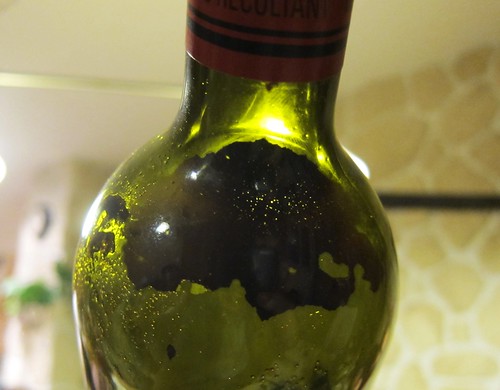
Quite some tartar in the Lapalu
And then it came, our first disappointment. 2008 Trilogia by Christos Kokkalis from Peloponese in Greece appeared very dark in colour with purple hue. A generous dose of cassis in the nose had us both instantly thinking of Cabernet and the intense vanilla smell indicated that it was also highly charged with oak. On the palate the wine appeared with great weight and a smooth texture witnessing well-integrated tannins. The fruit is again on Cassis, sweet and creamy, and only some sparce rosemary herb notes account for a touch of complexity. It was nearly balanced, also meaning that a bit more acidity would profit the wine and make it appear a bit less one-dimensional. Ironical, since the wine is called Trilogia. I have to admit that Didier’s description hits the nail on the head: a very modern and New World wine that is very hard to place on the world map. I also only got a hint of Terroir there with the herbs and I really expected much more from this one. I remember the 2005 to be much more complex. But let’s wait and see, maybe it is a question of ageing and I still have one bottle left.
Then, again a wine I haven’t had yet with the 2004 Clos Baquey by Elian Daros from the Côtes du Marmandais in South-West France. It showed a charming nose of Mediterranean profile with bouquet garni herbs and ripe fruit. On the palate, also delicious red and black fruits mixed with the same herbs. After a day it also showed meat or even bacon-like notes which were integrated very naturally into the big picture. I think I then said it tasted “like Pinotage should be supposed to taste”. Acidity and overall balance are good as well. I guessed the wine 4 years old – it had 6 and didn’t lack any freshness. Good Job by young star winemaker Elian Daros. I think Didier and I agreed on the quality of this wine. But it is also true that it didn’t stand out; maybe some extra-complexity was lacking.
Then, after our blind tasting assistant unsuccessfully tried to trick us by serving the simple Burgundy used as a cooking wine for the delicious Fondue Vigneronne we had for dinner, we came back to Southwestern France with 1996 Château Montus Cuvée Prestige from Madiran. The nose was again very meaty here and also with a certain smokiness. On the palate it showed quite delicious with red fruit, a good acidity and still lots of tannins, but not of the harsh kind. They were rather soft and grainy. Pretty hard to guess this wine 15 years old. Now I know how well Tannat can age. Also, we were very surprised to find no mark of sediment whatsoever in the bottle. On day 2 the deliciousness was even a bit more pronounced making me call the wine gouleyant. While the nose showed a bit more oak aroma, the red fruit and meat palate now had something that reminded the bloody juice of a medium rare steak. This was one of my favorite red wines of the tasting. Didier also enjoyed it, but I think he wasn’t as captivated as I was.
We stayed in the Southern Half of France with this young 2007 Domaine de Trévallon from the Bouche Du Rhône. The colour was appealing with a shiny dark purple. The nose showed very delicate and somewhat complex with cherries and cedar wood mixed to it in a not too prominent and thus quite pleasant way. I really enjoyed that nose much. It’s the palate that leaves some question marks. There we had the same nice cedar spice, some guarrigue herbs and lots of rather sweet fruit which seemed maybe a bit overripe, or a bit on the alcohol. And next to it, far from being integrated, some heavy tannins which are getting bigger and bigger with each hour. It seems that the pieces didn’t come together yet in this wine and it probably needs a lot of time to get there (if ever?). This also surprises me a bit since it didn’t strike me when I tasted it the first time. It will be interesting to taste it again in a few years and see how fruit and tannins get along then. I’m not sure if the advanced ripeness of the fruit compared to the tannin should make me a pessimist. What I’m sure about is that right now, it’s an underachiever.
The Domaine de Fondrèche 2009 “Nature” from the Côtes de Ventoux was the last red we got served blind. What a colour! Between black and fluorescent purple with a blurry thing to it. The nose is very straightfroward with baskets of black fruit but also with something reminding banana. I would lie if I didn’t say this tone reminded me of Beaujolais Nouveau: can I suspect some carbonic maceration in this wine? The technical sheet only mentions passive winemaking and no sulfites added. Anyhow, the wine is a fruitbomb, easily drinkable and offering good concentration and lightness at the same time, plus a lasting finish. A happy wine and probably a crowd-pleaser at any party. (In the past, I was also very satisfied with Fondrèche’s Cuvée Persia)
The Sweets
Then it was dessert time and we got back to Riesling, with some residual sugar of course. These were for Didier to guess since I brought both bottles. The 2009 Scharzhofberger Kabinett by Egon Müller definitely has the Saar slate aromas in the nose, mixed with lots of lemon. On the palate it feels light and balletic in weight. The fruit is very much on aromatic lemons, reminding indeed lemon sorbet as Martin from Berlinkitchen recently said for the 2008, but maybe also a hint of passion fruit. These aromatics were also well supported by an elegant acidity and subtle minerality. Lemons and freshness, as well as some slate aromatics linger on in a beautiful finish.
Didier was complaining about the lack of weight and called the wine watery. So again, Didier, let me tell you one thing, you Kabinett-ignorant, this is sheer purity and the representation of a classic Riesling style. It is supposed to be light and graceful. OK, I concede it would probably have had it right place at the beginning of the tasting, but still: focus on the purity! ;=)
That said, expectations are high with a 30 Euro Kabinett by Grand Poobah Egon Müller and I’m not sure whether I’m a little disappointed or not. But it would certainly not be the lightness disappointing me, but the level of complexity. I guess it probably needs a fair comparison with other Saar Kabinetts.
To finish the evening, what better than a Riesling Auslese? 2002 Kalkofen Auslese by Dr. Bürklin-Wolf from Wachenheim put back a smile on Didier’s face and I think we entirely agreed on this one. Superb golden colour, beautiful lemon nose. On the palate lemon mixed with Biscuit-dough, a brilliant interaction between elegant acidity and ripe fruit. Some minerality. But what impressed most was indeed this juiciness with lots of confit lemon and this incredible length – with lemon tea notes indeed, Didier! Time to go to bed!
Wow, that was an amazing tasting with great discoveries. Hard to tell which were my favorites. For the reds, I guess the Montus and Lapalu are taking the lead. Polished New World wines such as the Trilogia had no real chance against French Terroir wines. For the whites it is much harder to say since they all were of different styles but we definitely agreed on the Auslese to be in a really good shape. Personnaly, I was very happy to get a taste of Marcel Deiss’ famous coplanted vines and I think I’ll have to get into these a bit more thoroughly.
Thanks a lot Mizuki and Didier for having us over. Food was great, the atmosphere was brilliant, and although I needed a few days to recover from all these impressions, I’m already looking forward to the next blindtasting debauchery.
